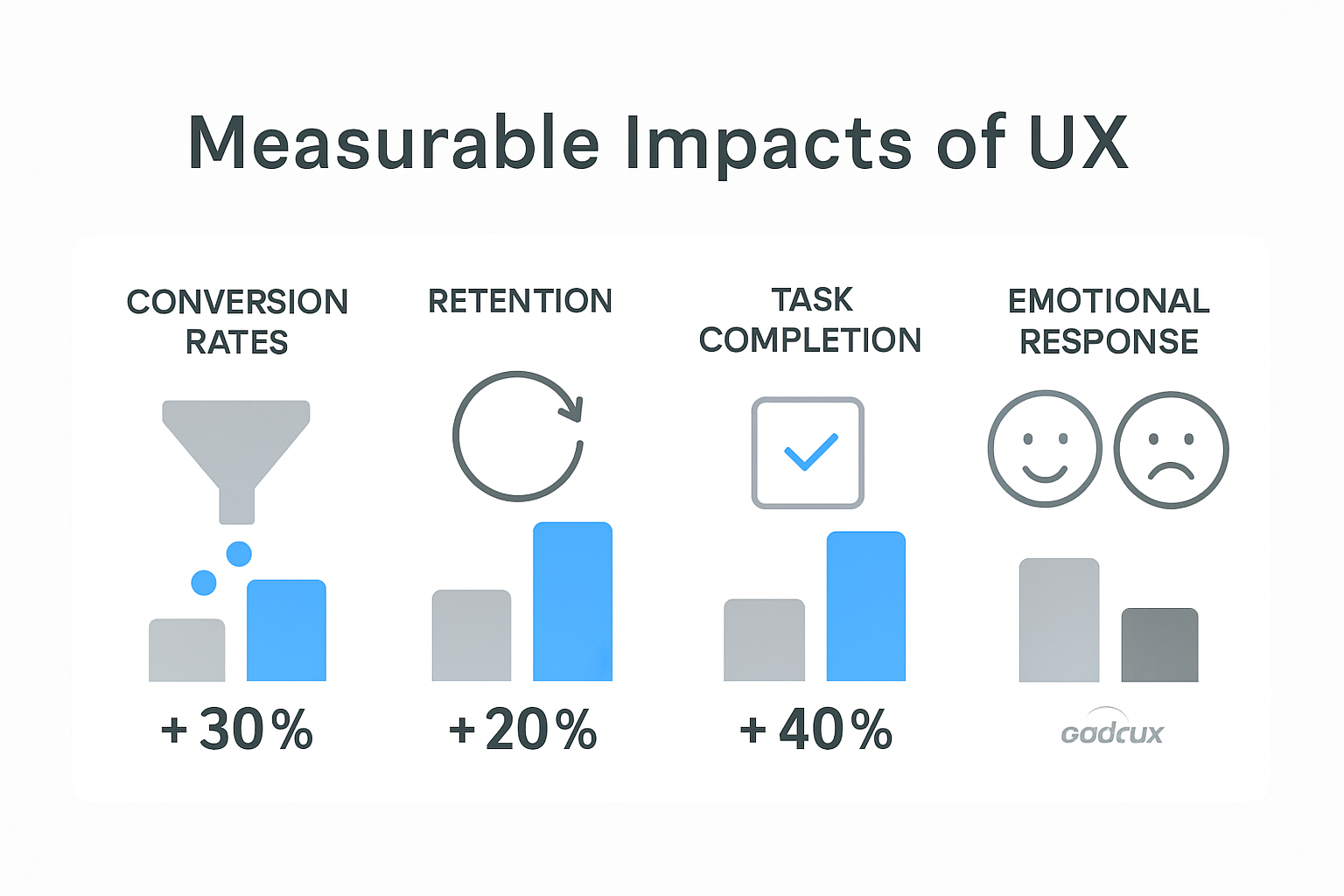User experience shapes the way businesses grow and how customers connect with brands. Turns out, the design and feel of your website or app are not just nice-to-haves. For every R1 spent on user experience, businesses can rake in up to R100 in customer satisfaction and conversions. That alone sounds impressive, right? But what most people miss is that the real power of UX is not only in the money saved or earned. The real advantage lies in how it quietly transforms casual users into loyal fans who keep coming back for more.
Table of Contents
- How User Experience Drives Business Success
- Enhancing Customer Satisfaction Through UX
- UX and Its Role in Digital Transformation
- Measuring the Impact of Good User Experience
Quick Summary
| Takeaway | Explanation |
|---|---|
| User experience directly influences business growth. | Exceptional UX leads to higher engagement, loyalty, and increased revenue for organisations. |
| Investing in UX yields significant returns. | For every R1 spent on UX, businesses can achieve up to R100 in customer satisfaction and conversions. |
| Technology enhances user experience. | Cutting-edge tools like AI enable personalised interactions, improving overall user satisfaction and engagement. |
| Customer satisfaction depends on user-centric design. | Understanding user psychology helps create meaningful connections, driving loyalty and positive emotional responses. |
| Measure UX effectiveness with multiple metrics. | Employ sophisticated metrics beyond basic traffic analysis to truly understand user interactions and satisfaction. |
How User Experience Drives Business Success
User experience (UX) has transformed from a design nicety to a critical business strategy that directly impacts an organisation’s bottom line. Modern businesses understand that exceptional user experiences are not just about creating visually appealing interfaces but about crafting meaningful interactions that drive engagement, loyalty, and ultimately, revenue.
The Economic Impact of User Experience
The financial implications of user experience are profound and measurable. A comprehensive study from Harvard Business Review reveals that companies investing strategically in UX see remarkable returns. For digital platforms, every R1 invested in user experience can potentially yield up to R100 in return through increased customer satisfaction and conversion rates.
Businesses that prioritise user experience witness tangible benefits across multiple dimensions:
To give a clearer view of how effective user experience impacts a business, here’s a summary of economic and strategic benefits outlined in the article:
| Benefit | Description | Supporting Statistic/Research |
|---|---|---|
| Conversion Optimisation | Well-designed interfaces drive more purchases or sign-ups | Up to 400% increase in conversion rates |
| Customer Retention | Intuitive experiences encourage users to return | Reduces user frustration & boosts loyalty |
| Brand Perception | Professional, user-friendly designs increase trust and credibility | Harvard Business Review study |
| Financial ROI | Return on investment in UX | R1 spent can yield up to R100 in returns |
| Personalisation | Tech-enabled interfaces tailor experiences to user preferences | AI & ML research from MIT |
- Conversion Optimization: Well-designed interfaces can increase conversion rates by up to 400%
- Customer Retention: Intuitive experiences reduce user frustration and encourage long-term engagement
- Brand Perception: Professional, user-friendly designs build trust and credibility
Technology and User Experience Synergy
Technological advancements have made sophisticated user experiences more accessible. Research from MIT indicates that modern businesses can leverage cutting-edge technologies like artificial intelligence and machine learning to create personalised, adaptive user interfaces that respond dynamically to individual user preferences.
The integration of advanced technologies allows businesses to:
- Predict user behaviour more accurately
- Provide real-time personalisation
- Create seamless, contextually relevant interactions
For businesses seeking to understand how to transform their digital strategies, our comprehensive guide on user experience design offers deeper insights into implementing effective UX principles.
Successful user experience is not about perfection but continuous improvement. It requires ongoing analysis, user feedback, and willingness to adapt. By viewing UX as a strategic investment rather than a cosmetic enhancement, businesses can create digital experiences that not only meet but exceed user expectations, driving sustainable growth and competitive advantage.
Enhancing Customer Satisfaction Through UX
Customer satisfaction represents the cornerstone of sustainable business growth, and user experience (UX) has emerged as the primary mechanism for delivering exceptional interactions that transform casual users into loyal advocates. By understanding and anticipating user needs, businesses can create digital environments that not only meet functional requirements but also generate emotional connections.
Psychological Foundations of User Experience
Research from Usability.gov reveals that user experience transcends mere interface design, diving deep into understanding human psychology and interaction patterns. Successful UX design considers cognitive load, emotional responses, and intuitive navigation to create seamless digital journeys.
Key psychological principles driving effective UX include:
- Cognitive Simplicity: Reducing mental effort required to complete tasks
- Emotional Resonance: Creating interfaces that feel natural and supportive
- Predictive Interaction: Designing systems that anticipate user needs
Measuring and Improving Customer Satisfaction
Measuring customer satisfaction requires sophisticated metrics that go beyond traditional quantitative assessments. A comprehensive study by Nielsen Norman Group demonstrates that effective satisfaction measurement involves combining multiple evaluation techniques, including:
- User behaviour tracking
- Sentiment analysis
- Contextual feedback mechanisms
- Performance metrics
Businesses can gain deeper insights into their digital experiences by exploring our detailed UX design strategies that focus on creating meaningful, user-centric digital interactions.
Technology as a Satisfaction Enabler
Advanced technologies now provide unprecedented opportunities to personalise and enhance user experiences. Machine learning algorithms can analyse user behaviour patterns, allowing businesses to create adaptive interfaces that evolve with individual user preferences. These intelligent systems can predict user needs, suggest relevant content, and streamline interactions across multiple digital touchpoints.
The future of customer satisfaction lies in understanding that technology is not just a tool but a bridge between business objectives and user expectations. By investing in comprehensive UX strategies that blend human-centred design with cutting-edge technological capabilities, organisations can create digital experiences that are not just functional, but genuinely delightful.
Ultimately, exceptional user experience is about empathy creating digital environments that feel intuitive, supportive, and responsive to individual user needs. It is a continuous journey of understanding, adaptation, and refinement that transforms transactional interactions into meaningful, memorable experiences.
UX and Its Role in Digital Transformation
Digital transformation represents more than technological upgrade it is a strategic reimagining of how businesses interact with customers, leverage technology, and create value. User experience (UX) sits at the heart of this transformation, serving as the critical bridge between technological capability and human interaction.
Strategic UX in Organisational Evolution
Research from the National Institute of Standards and Technology highlights that effective UX design is not merely a design consideration but a fundamental driver of digital innovation. Organisations that integrate user-centric thinking into their digital strategies create more adaptable, responsive, and competitive business models.
Key strategic considerations in UX-driven digital transformation include:
- Holistic Experience Design: Creating seamless interactions across multiple digital touchpoints
- Data-Driven Insights: Using user behaviour analytics to inform strategic decisions
- Continuous Adaptation: Developing flexible systems that evolve with user needs
Technology and Human-Centred Design
Modern digital transformation requires a symbiosis between advanced technologies and human-centred design principles. Emerging technologies such as artificial intelligence, machine learning, and adaptive interfaces are not replacing human interaction but enhancing it through more intuitive, personalised experiences.
Businesses can gain deeper understanding of these complex interactions by exploring our comprehensive digital transformation strategies, which emphasise the critical role of user experience in technological innovation.
Cultural Shift Towards User-Centricity
Successful digital transformation demands more than technological implementation it requires a fundamental cultural shift within organisations. This means moving from product-centric to user-centric thinking, where every technological decision is evaluated through the lens of user experience and potential impact.
Companies must develop:
- Interdisciplinary teams that blend technological expertise with design thinking
- Feedback mechanisms that continuously capture and integrate user insights
- Agile development processes that prioritise user experience
The future of digital transformation is not about technology alone but about creating meaningful, intuitive experiences that solve real user problems. By placing user experience at the core of digital strategy, businesses can create more engaging, efficient, and innovative digital solutions that genuinely meet user needs and drive organisational growth.
Ultimately, UX in digital transformation represents a profound shift from seeing technology as a tool to understanding it as a collaborative platform for human interaction, problem-solving, and value creation.
Measuring the Impact of Good User Experience
Measuring user experience impact goes beyond traditional metrics, requiring a comprehensive approach that captures both quantitative and qualitative insights into how digital interactions influence business performance. Modern organisations need sophisticated strategies to understand the true value of their user experience investments.
Key Performance Metrics for UX Evaluation
A comprehensive study on mobile application design reveals that effective UX measurement involves multiple interconnected metrics that provide a holistic view of user interaction and satisfaction. These metrics extend far beyond simple website traffic or click-through rates.
Critical UX performance indicators include:
To further clarify the practical metrics and analytic methods for assessing user experience, here’s a table highlighting the key evaluation approaches mentioned in the article:
| Metric/Technique | Purpose | Type |
|---|---|---|
| Conversion Rates | Measure how UX influences user actions and purchases | Quantitative |
| User Retention | Track long-term engagement and loyalty | Quantitative |
| Task Completion Efficiency | Assess how quickly and easily users achieve goals | Quantitative |
| Emotional Response | Capture subjective satisfaction and sentiment | Qualitative |
| Sentiment Analysis | Analyse user comments/interactions for mood/attitude | Qualitative |
| Predictive User Behaviour ML | Forecast future actions using AI and machine learning | Quantitative |
| User Journey Mapping | Visualise the entire experience and pain points | Mixed |
- Conversion Rates: Tracking how user experience directly influences user actions
- User Retention: Measuring long-term engagement and loyalty
- Task Completion Efficiency: Assessing how quickly and easily users accomplish their goals
- Emotional Response: Capturing subjective user satisfaction and sentiment

Advanced Analytical Techniques
Research in artificial intelligence and natural language processing demonstrates that modern businesses can leverage sophisticated analytical techniques to gain deeper insights into user experience. Advanced AI-driven tools can now analyse user feedback, sentiment, and behaviour patterns with unprecedented precision.
Key analytical approaches include:
- Sentiment analysis of user comments and interactions
- Machine learning algorithms for predictive user behaviour modeling
- Contextual feedback interpretation
- Comprehensive user journey mapping
Businesses seeking to understand the nuanced aspects of user experience can explore our detailed UX analysis strategies that provide actionable insights into digital performance.
Translating Insights into Strategic Action
The true value of UX measurement lies not in collecting data but in transforming those insights into strategic improvements. Successful organisations create continuous feedback loops that allow rapid iteration and refinement of digital experiences.
Effective UX measurement requires:
- Cross-functional collaboration between design, technology, and business teams
- Agile development processes that prioritise user feedback
- Continuous learning and adaptation mechanisms
- Investment in user-centric technologies and methodologies
Ultimately, measuring user experience is about understanding the human element behind digital interactions. It is a dynamic, ongoing process that requires curiosity, empathy, and a commitment to continuous improvement. By treating user experience as a strategic asset rather than a cosmetic consideration, businesses can create digital environments that not only meet but anticipate user needs, driving meaningful engagement and sustainable growth.

Frequently Asked Questions
What is user experience (UX) and why is it important for business growth?
User experience (UX) refers to the overall experience a user has while interacting with a product or service, particularly digital platforms. It is important for business growth because exceptional UX leads to higher customer satisfaction, increased engagement, and ultimately, higher conversion rates.
How can investing in user experience impact a business’s return on investment (ROI)?
Investing in user experience can significantly impact a business’s ROI. Studies show that for every R1 spent on UX, businesses can potentially earn up to R100 in customer satisfaction and conversions, reflecting the tangible benefits of a good user experience.
What are some strategies to measure customer satisfaction through UX?
To measure customer satisfaction through UX, businesses can employ techniques like user behaviour tracking, sentiment analysis, and performance metrics. These methods provide insights into user interactions and help identify areas for improvement in the user experience.
How does technology play a role in enhancing user experience?
Technology enhances user experience by enabling personalised interactions, predicting user behaviour, and creating seamless, contextual interactions. Advanced tools like artificial intelligence and machine learning help businesses tailor experiences to meet individual user preferences, thereby improving overall satisfaction.
Transform Your Customer Experience Into Business Growth
You have seen in this article how a strong user experience can directly drive your business success. Frustrated with websites or apps that never quite deliver what your audience needs? Not sure if your digital platforms are converting as well as they should? The truth is, every missed moment of engagement or confusing step in your online process could be costing you customers and real returns.
At Cloudfusion, we do more than just build websites. We help South African businesses like yours close the gap between user expectations and digital reality. Our experts craft tailored solutions that prioritise intuitive navigation, fast performance and real emotional connection with your users. Looking to turn research-backed UX principles into measurable growth? Get a free web design and development quotation or discover how our web development solutions can unlock loyalty and conversions for your brand. Start the journey today at cloudfusion.co.za and give your business the competitive advantage it deserves.
Recommended
- User Experience in Web Design: Best Practices for Businesses 2025
- Why Businesses Need Websites in 2025: Key Benefits Explained
- What Is Web Development? Essential Guide for Businesses 2025
- Brand Credibility: a Key Ingredient to Improved Conversion Rates
- User Experience Testing Strategies for CRO & Growth in 2025








